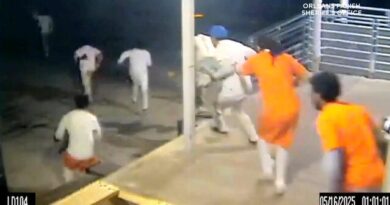Ancient Mayan city unearthed in Guatemala, including pyramids and a “unique canal system”
Archaeologists have unearthed the remains of a Mayan city nearly 3,000 years old in northern Guatemala, with pyramids and monuments that point to its significance as an important ceremonial site, the Central American country’s culture ministry said Thursday.
The Mayan civilization arose around 2000 BC, reaching its height between 400 and 900 AD in what is present-day southern Mexico and Guatemala, as well as parts of Belize, El Salvador and Honduras.
The city named “Los Abuelos,” Spanish for “The Grandparents,” once stood some 13 miles from the important archaeological site of Uaxactun, in Guatemala’s northern Peten department, the ministry said in a statement.
It is dated to what is known as the “Middle Preclassic” period from about 800 to 500 BC, and is believed to have been “one of the most ancient and important ceremonial centers” of the Mayan civilization in the jungle area of Peten near the Mexican border, it added.
“The site presents remarkable architectural planning,” with pyramids and monuments “sculpted with unique iconography from the region,” said the ministry.
The city takes its name from two human-like sculptures of an “ancestral couple” found at the site.
Guatemalan Ministry of Culture and Sports
The figures, dated between 500 and 300 BC, “could be linked to ancient ritual practices of ancestor worship,” said the ministry.
“Unique canal system”
The city, which covers an area of about six square miles, was discovered by Guatemalan and Slovak archaeologists in previously little-explored areas of the Uaxactun park.
Nearby, they also found a pyramid standing 108 feet high with murals from the Preclassic period and “a unique canal system,” according to the statement.
“The set of these three sites forms a previously unknown urban triangle… These findings allow us to rethink the understanding of the ceremonial and socio-political organization of pre-Hispanic Peten,” said the ministry.
Officials released a video showing archaeologists digging at the site and recovering a variety of artifacts, as well as an animation of the complex.
Guatemala’s Culture and Sports Ministry
In April, scientists discovered a 1,000-year-old altar from Mexico’s ancient Teotihuacan culture at Tikal, elsewhere in the Peten department.
That find was interpreted as proof of ties between the two pre-Hispanic cultures, which lived about 800 miles apart. Archaeologists also said that the altar was believed to have been used for sacrifices, “especially of children.”
Tikal, about 15 miles from Uaxcatun, is the main archaeological site in Guatemala and one of its biggest tourist attractions.
Last October, an American doctoral student discovered a sprawling Maya city within a dense jungle in Mexico.
Scientists and archaeologists have discovered ancient Mayan ruins by shooting lasers down from a plane to penetrate the dense jungle.







